When small and medium isn’t quite what fits, maybe something in-between will.
That’s Mazda’s idea in bringing out the CX-30, the company’s newest but not smallest crossover that’s also not quite medium, either.
It has some of the attributes of both – as well as some things that aren’t available in either.
What It Is
The CX-30 is a not-quite-compact and just shy of being a mid-sized/five-passenger crossover SUV.
It bridges the gap between the smallest Mazda crossover, the CX-3 and the larger CX-5, offering more power than you can get in a CX-3 for much less money than you’d pay to get the same power in a CX-5.
Prices start at $21,900 for the base trim, which comes standard with front-wheel-drive and the same 2.5 liter engine that’s the base engine in the CX-5 and which is much stronger than the 2.0 liter engine that’s the only available engine in the CX-3.
/
AWD is optional in the base and the other trims – Select, Preferred and Premium – the latter topping the price range at $29,600 with AWD.
For reference, the less powerful – and less large – CX-3 starts at $20,640; the equally powerful and a bit larger CX-5 starts at $25,900.
What’s New
The CX-30 is a new addition to Mazda’s model lineup.
What’s Good
The power of the CX-5 without the price – or the size.
More size inside than the CX-3 – and for not that much higher a price on the window sticker.
The looks – and fun to drive attributes – of its bookend brothers.
What’s Not So Good
It’d be more fun to drive if you could get it with a manual transmission.
It’d be a lot more fuel-efficient if you could get it with Mazda’s diesel engine.
The good looks make it a bit less practical than some others in the same general class, such as the smaller on the outside but roomier inside Honda HR-V.
Under The Hood
Whoever was responsible for the CX-30 over at Mazda may have a picture of John DeLorean on his desk.
The father of the 1964 GTO – who created it by putting a bigger car’s engine in a smaller car. Which is what whoever designed the CX-30 did.
Now, the CX-30 isn’t a 389 GTO.
But it’s not a CX-3, either.
Not that there’s anything wrong with the CX-3. It’s just not packing much under its hood.
The CX-30 is packing more.
More displacement – and much more power. Instead of 2.0 liters, 148 hp and 0-60 in 8.2 seconds or so, 2.5 liters, 186 hp and 0-60 in just over 7. Which – no kidding – is very close to what a 1964 GTO with a 389 (6.5 liter) V8 delivered.
Without delivering 25 MPG in city driving and 33 on the highway. Divide that by half, for the GTO.
The Mazda’s engine also has much higher compression than the ’64 GTO’s engine: An astounding 13.0:1 vs. 10.75:1 back in ’64. And yet – cuing Blues Brothers voice – it runs on regular (unleaded) gas. The GTO had to have premium – leaded – gas and would have needed race gas to safely run 13.0:1 compression back in 1964.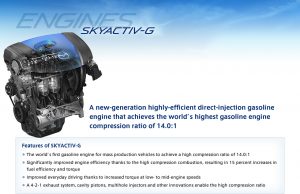
How does the Mazda get away with running the same compression on regular? This is “SkyActive” technology, Mazda’s term for its proprietary blend of combustion-chamber/piston/fuel-injector design that enables a gas engine to approach diesel engine compression without dieseling – uncontrolled combustion, which in a gas engine leads to things like broken pistons.
Mazda uses this approach rather than the turbocharged approach – which also increases cylinder pressure, which makes more use of the fuel (and makes more power) but makes it using more parts and – often – requires premium fuel to make it.
Here, you get the power without the turbo or the extra cost of premium.
You also get more realistic mileage. A smaller – and turbo’d – engine might advertise higher mileage but you’ll only get it if you don’t use the turbo (the boost). If you do, you’ll use more gas. The 2.5 engine’s advertised mileage is closer to what you’ll actually get because the engine doesn’t need a boost to make its advertised power.
A six-peed automatic is standard in all trims but you have the option to go FWD or AWD, as you like.
If you buy the AWD version, you’ll get a bit less gas tank – 12.7 gallons of capacity vs. 13.5 for the FWD version. This makes the AWD-equipped CX-30 seem thirstier than it is – which it isn’t.
With AWD, the CX-30 delivers 24 city, 31 highway – almost the same mileage touted by the FWD version but your range on a tankful is about 24-31 miles less, because there’s less gas in the tank.
Mazda had toyed with offering a diesel engine in some of its offerings and might have offered it with this one.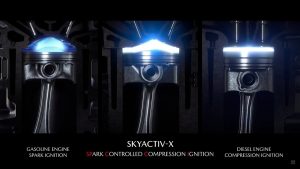
It pulled back on that because of the expense and ordeal of complying with federal regs that seem designed to stamp diesels out of existence, probably because they are an existential threat to electric cars – which are being practically forced down the car buying public’s gullet.
If Mazda had been able to offer a diesel in the CX-30, it probably would have been capable of going farther than 40 miles on a gallon – and going for 600 or 700 miles without refilling.
And without costing $40,000.
Which probably explains why American car buyers aren’t allowed to buy it.
Americans also can’t have the manual transmission which is available in the CX-30 in Europe and other markets.
Also because Uncle. Because manuals don’t score as highly on Uncle’d fuel economy tests and because manual-equipped cars are harder to tune to meet Uncle’s emissions tests.
Mazda vehicles are not the most practical vehicles – even when the model is a type that touts practicality.
But they are close to the practicality leaders – in terms of such things as passenger and cargo room, as well as fuel efficiency – while almost always being much more fun to drive as well as more enjoyable to look at.
The CX-30 doesn’t depart from this tradition.
For openers, the winning mix of more engine than similarly sized models like the Honda HR-V, which has nothing larger than 1.8 liters under its hood – and 141 hp. It needs almost ten seconds to get to 60.
For seconds, the Mazda comes with a six-speed geared automatic rather than a continuously variable (CVT) automatic, the latter rapidly approaching default standard (and only available) transmission in this class. Chiefly because CVTs are more . . . practical.
Well, more economical.
There is a slight fuel efficiency edge vs. a conventional automatic with set gears (e.g., 1-6) rather than a ratio that can be varied continuously. But transmissions that shift through the gears feel more responsive; there are downshifts and upshifts rather than the continuous surge delivered by the CVT.
And the mileage difference, as it turns out, is not much. The FWD version of the HR-V delivers a claimed 28 city, 34 highway – a difference of about 2-3 MPG in exchange for about the same difference 0-60, which is much.
There is also handling, which Mazda emphasizes, too – even at the cost of a little practicality. The CX-30 has 6.9 inches of ground clearance, a bit less than models like the Subaru Crosstrek, for instance – which has 8.7 inches.
So it’s not quite the snowmobile that some are. But being closer to the ground has its advantages when there’s no snow on the road and you’re wanting to go through a corner, faster.
Which this one does better than those that ride higher.
Here again the Mazda echoes Pontiacs – the old, cool ones. In addition to putting big car engines in smaller cars, Pontiac was admired by people who loved cool cars for designing cars that had an approaching luxury-car ride while handling better than many muscle cars – which rode like hand trucks.
Some will remember the Radial Tuned Suspension Pontiac developed back in the early ’70s – along with the Wide Track and other such boons that resulted in performance cars that felt like luxury cars.
The CX-30 feels that way, too – even though it is technically neither.
The CX-30 looks a lot like the CX-3 and the CX-5 . . . until you take out the tape measure. It’s about half a foot shorter overall than the the CX-5 and about the same longer than the CX-3.
173 vs. 179.1 vs. 168.3 inches, respectively.
These exterior dimensional differences translate into a bit more second row legroom (36.3 inches) than inside the CX-3 (35 inches) and a bit less second-row legroom than in the CX-5 (39.6 inches).
All three have about the same front seat legroom (41.7 inches for the CX-3).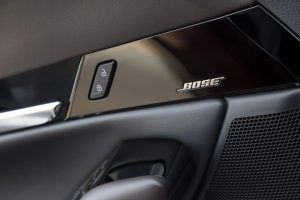
The same differences can be measured in cargo capacity. The CX-30 has 20.2 cubic feet behind its second row and 45.2 with its second row folded flat – vs. 17.8/42.7 (respectively) in the CX-3 and 30.9/59.6 (also respectively) in the CX-5.
Regardless, there is abundant – and more usable – room in these little crossovers, which accounts hugely for their rampant popularity. With the CX-3’s back seats folded, two can almost sleep on the resultant floor space.
That’s something you couldn’t do in a GTO.
But like those old GTOs, flair is a big part of the CX-30’s appeal. Which is a harder thing to manage than with a muscle car, where function takes a third row seat to form. But Mazda makes form a priority. The CX-30 has plenty of form – without giving up much to function. And this form isn’t the usual catfish-faced or angry Kabuki Samurai face, either.
The CX-30 looks very much like the higher-riding sportwagon it’s closer to being than just being another crossover.
Inside, there’s personal car flair – something John Z would appreciate if he were around to see it. The dash sweeps in graceful arcs, all focused on the driver. Most of the vital secondary controls are physical knobs or button, so you can control vitals like the temperature/fan without taking your eyes off the road to tap or swipe.
There is a touchscreen for the secondary functions – including the stereo – and while it’s nicely positioned (canted slightly toward the driver) its input system isn’t the best. You have to select a given app or whatever you’re trying to access from one menu, then select again to make adjustments.
But the upside is you don’t have to touch the screen in order to drive the car.
The Rest
The engine doesn’t stop – until you turn it off.
The CX-30 is one of the few new cars of any type you can buy not equipped with ASS – Automated Stop/Start “technology” – as it’s styled. Mazda figures the trivially small fuel savings that can be achieved by killing the engine at every red light is outweighed by the cost of the repetitive annoyance of all that stop-starting.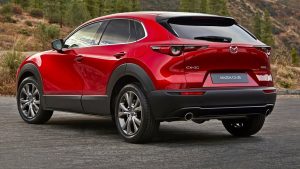
Unfortunately, the pull-up emergency brake has been replaced by an electric and automatically engaging parking brake. This frees up some space on the center console but costs a bit of control – and fun.
No more bootleg turns.
A small nit.
It is hard to find big ones.
The Bottom Line
The CX-30 could also have been named the Goldilocks – since it might to be just the right size.
Plus some other right things.
. . .
Got a question about cars, Libertarian politics – or anything else? Click on the “ask Eric” link and send ’em in!
If you like what you’ve found here please consider supporting EPautos.
We depend on you to keep the wheels turning!
Our donate button is here.
If you prefer not to use PayPal, our mailing address is:
EPautos
721 Hummingbird Lane SE
Copper Hill, VA 24079
PS: Get an EPautos magnet or sticker or coaster in return for a $20 or more one-time donation or a $10 or more monthly recurring donation. (Please be sure to tell us you want a magnet or sticker or coaster – and also, provide an address, so we know where to mail the thing!)
If you’d like an ear tag – custom made! – just ask and it will be delivered.
My latest eBook is also available for your favorite price – free! Click here. If that fails, email me at EPeters952@yahoo.com and I will send you a copy directly!


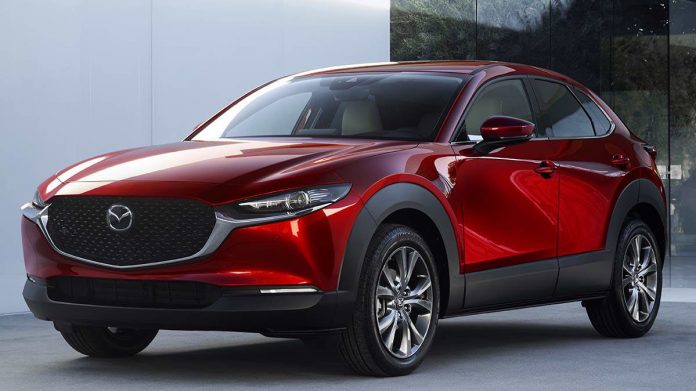

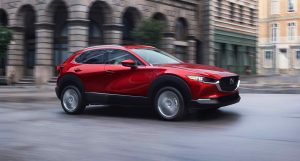
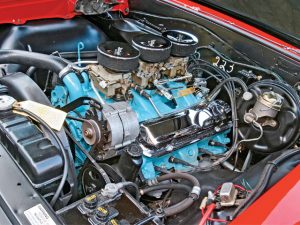
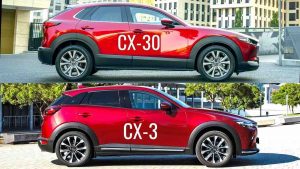








“You also get more realistic mileage. A smaller – and turbo’d – engine might advertise higher mileage but you’ll only get it if you don’t use the turbo (the boost). If you do, you’ll use more gas”.
I have also owned and driven several cars and I have never experienced the phenomenon mentioned above. I.e. my fuel consumption under normal driving conditions has always been close to advertised numbers, with or without a turbo. What happens when people use their personal car as a racing car I don’t know, but we can assume that most people use their cars under normal driving conditions most of the time.
It is also my experience with modern cars with turbo, that they may use slightly less fuel under the same conditions, than cars with similar horsepower but without a turbo but with a larger displacement.
Note that I am referring to modern cars with turbo. In the 70’s and 80’s cars with a turbo used noticeably more fuel that cars without turbo, but with a larger displacement.
Hi Jone,
I’ve been test driving new cars (all makes, all models) every week for almost 30 years. That’s a lot of cars. So I think I can speak to this with some authority. If you “put put” around, then you may realize the advertised mileage. But if you use the advertised power, you will not realize the advertised mileage.
Bear in mind that the only reason for the now-widespread use of turbos in ordinary cars (not performance cars) is to make up for lost displacement; in other words not as a power-adder (as in turbo’d performance cars) but to replace the power lost due to engine downsizing for the sake of scoring better on government fuel efficiency tests.
But the Catch 22 is that if you use the power, you also use more fuel. A larger engine will, too, of course – if used hard. But it doesn’t need to be used as hard as the small, turbo’d engine – which is weak unless it’s on boost. Which means using the boost more often…
It’s a gyp, in other words.
Keep in mind, too, that the turbo’d (and often also intercooled) engine is more complex, with more parts – and that’s not without cost, either.
There’s really no sound reason for replacing a naturally aspirated V6 with a four that’s turbo’d. It’s all done for reasons of placating the government – very much of a piece with electric cars.
Don’t know if it’s still prevalent but the first turbo’d vehicle I drove had pronounced turbo lag. Haven’t had much interest in turbos since.
Hi Liberty,
The turbo lag issue is much reduced via improvements such as “twin scroll” turbos that hug the exhaust ports and get their pulses from different ports. But there is still generally a slight but noticeable pause when you floor a turbo’d car from a standstill. My main worry, though – if I were considering the purchase of a turbo’d car – would be the long-term longevity of the turbo and related components. But, I’m the rare bird (these days) who keeps a car for 15-20 years rather than 6-8. You probably won’t have problems if you trade/sell the car before it is ten years old or so. But if you keep it longer…
“But, I’m the rare bird (these days) who keeps a car for 15-20 years…”
I’m on your side – last car I sold had for 35 years (original owner) and was a daily driver – ’78 Camaro Z28. When sold, still had the original engine (350 cu in) and trans, Turbo Hydramatic 350.
Hi Libertyx,
I bet you regret selling the Z28! I had a ’78 myself, once. Had it not been for bald tires, a wet road and me feeling the need for speed, I’d probably still have it!
Eric,
What a story – Camaro Z28 gave up its life for its driver…! Hope you’ve had a yearly commemoration:)
Hi Liberty!
Yup; I will write about it soon. My first – and only – crash. I was 19, poor – and spent money on heads and a cam instead of new tires. Ah well. One lives, one learns!
There is the ugly grill trend and with it the “throw-black-cladding-at-it” trend, both ugly. The only colors that look OK with the cladding are black and dark grey.
Also: In lieu of auto stop/start Mazda is incorporating Active Fuel Management (cylinder-deactivation) –
undesirable.
About year 2012 remains the last year of desirable newer vehicles. Or, I’ll take the one that for me got away – a ’67 GTO – I didn’t buy it.
Better buy a tuner chip and turn off that “feature” before it damages the engine.
I paid $400 for a custom tuner chip to turn off cylinder deactivation on my Suburban…on that engine at least it was notorious for causing high oil consumption (e.g. 1 quart every 200 miles of highway driving) & piston damage…Chevy ended up replacing whole engines for some customers.
WOW! When I go looking for a somewhat practical, but not “too” practical…. quicker, but not really fast, contender in the “medium small” CUV segment, I’l definitely check out the CX-30! 😉 It’s fairly good looking though….and no CVT. I’ll give it credit for that.
The “DeLorean/GTO” analogy is kind of a stretch. Don’t think they’re going to be writing hit pop songs about this one.